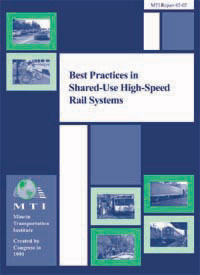- 408-924-7560
- mineta-institute@sjsu.edu
- Donate
Best Practices in Shared-Use High-Speed Rail Systems
A high-speed rail system is intercity passenger ground transportation that is time-competitive with air and/or auto for travel markets in the approximate range of 100 to 500 miles, and these systems are increasingly gaining attention in the United States. Many states are developing proposals for new HSR systems designed to solve critical transportation problems, especially the growing congestion on our highway and airport systems. Highspeed rail is also viewed as a way to focus growth and development around stations as well as to serve as a catalyst for economic growth.
There is significant international experience in building and operating HSR systems that can be helpful in planning U.S. systems. One of the key challenges for U.S. high-speed rail planning is to take full advantage of foreign experience while ensuring that no degradation of safety or unmitigated environmental effects result from the deployment of foreign technology in North America. Shared-use HSR systems are railroad infrastructure, rolling stock, and operating strategies that are used by both high-speed trains and conventional service (for example, freight, commuter rail, and intercity passenger rail). This research describes shared-use HSR systems, an important strategy for improving the feasibility of highspeed rail. In shared-use HSR, high-speed passenger trains use the same tracks and infrastructure as slower passenger or freight trains.
This research report will be most interesting to HSR system planners and managers who want to learn about shared-use techniques. Because many of the strategies used in Europe were found to be based on traditional railroad engineering techniques for increasing capacity and speed, and therefore fairly well known to railroad engineers, the report will be useful to them mainly as a comprehensive listing of potential strategies for improving shared-use operations. The report will also be interesting for those who want to learn more about high-speed rail planning in general.
Andrew Nash, P.E.
The report’s principal author was Andrew Nash, an independent transportation planning consultant living in Zurich, Switzerland. Nash was Executive Director of the San Francisco County Transportation Authority before moving to Europe. As Executive Director of the Transportation Authority, he was responsible for managing a government agency with an annual budget of more than $100 million. The Authority allocated funds for capital projects to the city’s transportation agencies and completed long-range transportation planning for San Francisco.
Before coming to the SFCTA, Nash was Project Manager for the Caltrain commuter railroad. There he directed several large and controversial transportation engineering studies, including extending the railroad to a new multimodal transportation terminal in downtown San Francisco and an airport-rail-Caltrain connection project. Nash came to Caltrain from Santa Clara County, where he was Director of Congestion Management. Nash earned a Master of Civil Engineering and a Master of City Planning from the University of California, Berkeley in 1987. He earned a Master of Science in Transportation from Northeastern University in 1983 and a Bachelor of Science in Civil Engineering from Rensselaer Polytechnic Institute. He is a registered Professional Civil Engineer in California.
Nash has authored several publications, most recently Implementation of Zurich’s Transit Priority Program (available at www.transweb.sjsu.edu). Other publications include "Caltrain Rapid Rail Program," TRB Annual Meeting 1999; "Public Decision Making for the Caltrain Downtown San Francisco Extension Project," Transportation Research Record 1571, March 1997; "California’s Congestion Management Program," ITE Journal, February 1992; "Effective Citizen Involvement in the Transportation Planning Process," TRB Annual Meeting, 1990; and "Vehicle Pooling in Transit Operations" (with Peter Furth), American Society of Civil Engineers, Journal of Transportation Engineering, May 1985.
Nash has also served as an officer for several nonprofit organizations in the San Francisco Bay Area, including President of Greenbelt Alliance and Board Member of the San Francisco Urban Planning and Research Association. Nash also ran unsuccessfully for election to the Bay Area Rapid Transit District Board of Directors in 1992.
-
Contact Us
San José State University One Washington Square, San Jose, CA 95192 Phone: 408-924-7560 Email: mineta-institute@sjsu.edu






